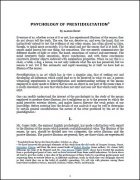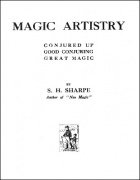Theory, Articles & Reviews in Magic & Mentalism: page 5
Authors
Products
The Secret Gate
Dartagnan
The oldest, most pernicious, and insoluble problem in the history of magic was stated best by Henning Nelms, in his 1969 Magic and Showmanship: A Handbook for Conjurers ...
"No matter how astonishing a trick may be, it suffers from one major fault - it has no point."
This ebook is the long-sought-after answer to that statement.
[Please note that access to appendix 11 and 12 requires registration at the author's website.]
- Acknowledgements
- Foreword by Eric Evans
- Preface
- A Long Time Ago
- A Lot of Simple Tricks and Nonsense
- Best Star Pilot in the Galaxy
- Scum and Villainy
- Hokey Religions and Ancient Weapons
- What Are You Trying To Push on Us
- Tremor in the Force ...
Psychological Notes Upon Sleight-of-Hand Experts
Joseph Jastrow
Jastrow wondered if the pursuit of sleight-of-hand conjuring develops any special motor or mental powers. He invited Alexander Hermann and Harry Kellar and put them through a range of tests comparing them to average folks. In this article you will find out how these two giants of conjuring compare to the average.
From the introduction:
Having recently enjoyed visits at my Psychological Laboratory from Messrs. Hermann and Kellar, the widely-known prestidigitators, I put together the results of the series of tests to which they kindly submitted. As the time at my disposal for these tests was limited,...
The Psychology of Conjuring Deceptions
Norman Triplett
This study identifies deep lying instincts and impulses of the psychic life are the basic elements in conjuring. Its aim is to show the psychological reasons of deception of a magic effect. It also provides an extensive classification of magic tricks.
Contents:
- Origin of Conjuring.
- Classification and Typical Examples of Modern Conjuring Tricks.
- The Training of the Conjurer.
- Psychological Justification of the Rules and Practices of the Conjurer, treated under
- Attention
- Perception
- Suggestion and Association
- Suggestion and the Law of Economy
- Sociological and Pedagogical Observations. ...
A Comparison of the Gravatt and Hugard Encyclopedias of Card Magic
William B. Rugh
This work compares the contents of Jean Hugard's Encyclopedia of Card Tricks, Encyclopedia of Self-Working Card Tricks, and The Second Encyclopedia of Card Tricks by Glenn G. Gravatt, to see which effects and discussions were kept, altered, or deleted by Hugard. It will also identify those effects added by Hugard.
1st edition 2020, PDF 19 pages.
Magic Backup
Brian T. Lees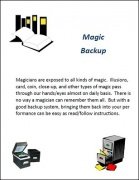
Magicians are exposed to all kinds of magic. Illusions, card, coin, close-up, and other types of magic pass through our hands/eyes almost on a daily basis. There is no way a magician can remember them all. But with a good backup system, bringing them back into your performance can be easy as read/follow instructions.
- Preface
- What is backup and purpose?
- Where do I start?
- Time to input information
- Cross reference sheets
- Keep it up
- Wrapping it up
1st edition 2020, PDF 16 pages.
The Psychology of Legerdemain
Max Dessoir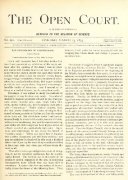
This is an interesting analysis of how a magic trick works in terms of psychological processes. A better understanding of the underlying science does help the performing magician.
Translated from the German by Mrs. Emily S. Boyer. The original German essay appeared in Psychologische Skizzen by Edmund W. Rells, which was a pseudonym of Max Dessoir.
1st edition 1893, PDF 21 pages.
Fogelism: An Attitude to Life
Maurice Fogel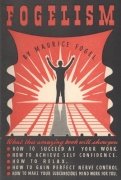
The famous British mentalist, Maurice Fogel, leveraged his success as performer to branch out into the self-help category, by writing this book. He writes:
There is no strange mysticism about Fogelism; it is simply a mental attitude towards life which, I have found, achieves unsuspected results. It is the logical training of one's mind so that it sizes up the approach to a problem and tackles it rationally, instead of allowing the magnitude of that problem to overwhelm.
- Foreword
- The Mind Is Lazy
- Controlled By Subconscious
- Secret Of Hypnotism
- Learn To Relax
- Power Of Suggestion ...
The Fortune Formula: Fogel's Top Secrets No. 2
Maurice Fogel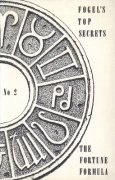
In this second manuscript in Fogel's Top Secrets series, he explains his system of how to develop a new routine, what he calls "The Fogel Formula". It is a system of how to structure and proceed with your training and development towards a particular goal. Fogel is using his success system for things he wants to achieve in general not just magic.
Fogel demonstrates how his formula operates by applying it to a question he often received after his shows: "Can you tell fortunes?" To address this frequent question he developed a particular routine involving a zodiac chart. The chart, the routine,...
Performance Close
Brian T. Lees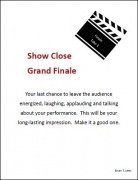
The close of your performance is your last chance to make a lasting impression on your audience. It should bring the audience to the peak of excitement, energize them and leave them talking about your magic. This text identifies the goals of the close. It provides examples and suggestions to help you develop a strong, effective close. Future performances often depend on the posture you leave your audience. Pull out all the stops, use all your tools to make your close one to be remembered.
- Basic Show Composition
- The Build Up
- Close Goals
- Tools for The Close
- Sample Closes
- Document
- Wrapping...
The Wit and Wisdom of Mark Lewis
Mark Lewis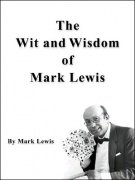
It's witty and it's full of wisdom. These are the ramblings of Mark Lewis on Internet forums. Irreverent and funny at times and full of deep thinking about magic and mentalism at other times.
Many incredible anecdotes of his varied life as a fortune teller, magician and hypnotist. In addition to this are techniques described on how to pitch svengali decks, how to do psychic readings, and most important of all how to do magic with showmanship and verve.
Included is a video clip of his legendary svengali deck routine which he has performed all over the world thousands of times plus tips...
Performance Opening
Brian T. Lees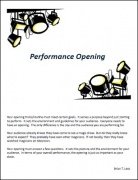
The two most important elements of a performance are the opening and close. The opening sets the environment for the audience to be entertained. The close is the magician's last chance to leave a lasting impression on the audience. To be effective, the opening must meet specific goals. This text identifies them and provides ideas, samples and recommendations to help the magician attain them.
- Show Structure
- Primary Opening Goals
- Types of Opening
- Opener Planning
- Sample Openings
- Document
- Wrapping It Up
The Book Without Words
Mihwonkuoy Refizul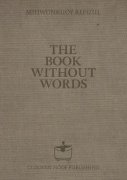
The real secrets on how to become the greatest magician in the world. Dedicated to the discerning conjurors, the cheaters, the liars, and all other lost souls - whatever age, who want to impress, manipulate, and magish other people for profit, fun, or just entertainment.
Included is a very clever and creative book test, for all of you who require a strong effect to justify the purchase.
The truth is delivered as a satire, which makes it a fun read, but at the same time delivers a profoundly deep and true message.
- About the Author
- Part One
- Introduction
- The Basic Principles
- The...
Entertaining by Magic
Hermann Pallme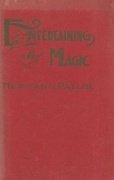
Not a trick in the ebook, but contains more real information on how to entertain with magic than you can get by reading a hundred others. Gives details so frequently neglected. Invaluable to any magician, for not only must one know how to do tricks, but he must also understand how to make his tricks entertaining.
- Preface
- Hermann Pallme
- Foreword
- CHAPTER I. History Of Magic
- CHAPTER II. The Literature Of Magic
- CHAPTER III. Educational Value Of Magic
- CHAPTER IV. Magic As A Profession
- CHAPTER V. The Study And Practice Of Magic
- CHAPTER VI. Concerning Deportment
- CHAPTER VII. The Dramatic...
Misdirection for Magicians
Dariel Fitzkee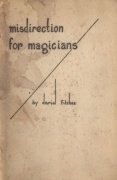
This is an early version of what would eventually become Magic by Misdirection.
A detailed analytical treatment of the principles and methods. Explores the psychological basis and its adaptation to the performance of magic. Many detailed ruses included covering the entire field. How to develop misdirection to fit all situations. What it is and how it works. The first concrete work on a subject that is common to all effects and all performers.
Paul Fleming wrote:
Every magician knows - or ought to know - that misdirection plays a vital part in the creation of a perfect...
The Creative Mind
Don Bursell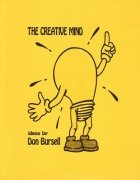
With 1000s of magic routines available, why do many magician's perform the same routines, without any change, modification or effort to make those routines unique?
The Creative Mind is simply Don Bursell's ideas for creating new routines, brainstorming new variations, and keeping track of those ideas.
The 2nd half are tricks that Don has created over the years, and based on advice from Jon Racherbaumer, wrote them down so as not to forget them. One of them, Headmover, has been an odd signature piece of Don's programs for over 20 years. Another routine, The Needles, is Don's solution to the East Indian...
Professional Show Development
Brian T. Lees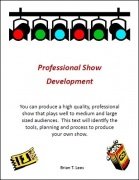
You do not have to hire a director, choreographer and technical designer to produce your own professional show. This ebook covers the environment, building your outline of magic, using music, and developing your show. Learn how to fine tune your performance through rehearsal, problem area recognition and the flow from opening to your finale. A high-quality professional production is within your grasp using a lot of materials you may already own.
- Set the stage
- Backdrop
- Sound, P/A System
- Music
- Lights
- Working tables, etc.
- Transporting
- Cases, boxes, bags trunks and carts.
- Show components ...
The Bibliography of Conjuring - and kindred deceptions
Sidney W. Clarke & Adolphe Blind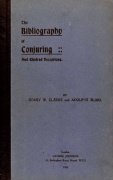
This bibliography collects about 2000 works that deal with tricks and illusions, and with the varied deceptions that are usually presented as part of a conjuring entertainment, including automata, chapeaugraphy, chemical and electrical tricks, escaping, fire handling, gamblers' tricks, hand-shadows, juggling, lightning sketches, optical illusions, pseudo-spiritualistic manifestations, second sight, thought reading, thought transference and ventriloquism. The list includes languages other than English in particular German and French books. Excluded are books on the so-called occult arts, but...
Good Conjuring
Sam Sharpe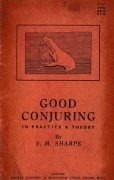
- Part One: Good Conjuring
- The Objects Used
- Misdirection
- Construction
- Characterisation
- Technical Mastery
- Dramatic Ability
- Manner
- Speed Of Presentation
- Style
- Magic-Artist Versus Showman
- Summary
- Part Two: Poems In Illusion
- Catching The Post
- Card Bubbles
- Love: The Magician
- The Two Jewels
- Reflected Thoughts
- Citizens Of The World
- The World’s Pearl
- Poor Yorick!
- Alice In Conjureland
1st edition 1936, 40 pages; 1st digital edition 2019, 39 pages.
Conjured Up
Sam Sharpe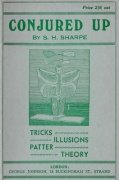
- Part One: Good Conjuring
- The Essence Of Magical Criticism
- Audiences
- Audience Mentality
- Conditions Of Presentation
- Variety Of Methods Desirable
- The Elements Of Magic
- The Magical Plot
- The Dramatic Plot
- Fantastic And Pseudo-Scientific Plots
- Pure, Story, And Symbolic Magic
- Part Two: Poems In Illusion
- Narcissus
- By Candle Light
- The Nervous Card
- The Invisible Silkworm
- Domination Of Thought
- Thoughts Are Things
- Mediaeval Multiplication
- The Bluebells
- Fantail
1st edition 1935, 40 pages; 1st digital edition 2019, 37 pages.
Great Magic
Sam Sharpe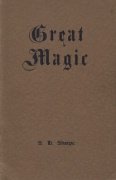
From the preface:
When Neo Magic was finished I thought I had said all there was to say on "The Art of the Conjurer"; but before that book was off the press I found myself jotting down fresh observations on this fascinating, though neglected, subject. Magic Artistry is the result, which may be said to supplement Neo Magic.
Many of the ideas put forward herein will be new to most conjurers; and, through being strange, may seem obscure or outlandish; but such an impression will doubtless pass as their meaning is grasped; though this may not be until the book has been carefully studied several times to get the mind in harmony...
Neo-Magic
Sam Sharpe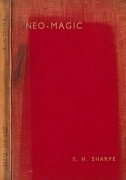
The art of the conjurer.
Neo-Magic is the foundation for all of Sharpe's writing. Sharpe offers great insight into what makes magic magical. Starting with an analysis of art and its relationship to magic, Sharpe explores what he feels is needed for magic to become a fine art. He provides his insight into topics as originality, patter, styles of presentation, program construction, stage fright and others.
From the preface to the second edition:
What I have been doing over a considerable number of years is to find out, if possible, whether the answer to the question "Is conjuring a Fine...
